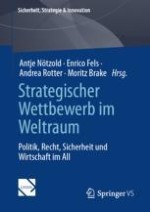2024 | OriginalPaper | Chapter
Aktive Beseitigung von Weltraumschrott zur Aufrechterhaltung und Weiterentwicklung des Ökosystems Weltraum
Authors : Alin Olimpiu Albu-Schäffer, Thomas Dekorsy, Gerhard Grunwald, Wolfgang Riede, Stefan Scharring, Máximo A. Roa
Published in: Strategischer Wettbewerb im Weltraum
Publisher: Springer Fachmedien Wiesbaden
Activate our intelligent search to find suitable subject content or patents.
Select sections of text to find matching patents with Artificial Intelligence. powered by
Select sections of text to find additional relevant content using AI-assisted search. powered by
